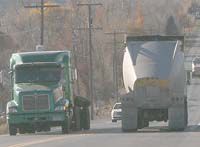| Traffic numbers along S.R. 10 help make the Price area one of the most busy rural communities in the state. |
Most Carbon County residents realize that U.S. Highway 6 carries more vehicle traffic than Interstate 70 does from the Colorado border to Fremont Junction.
But many people in the local area may be surprised to learn that Utah State Road 10 from Huntington to Price also carries more vehicles.
“I know I was surprised when I saw the figures,” pointed out Carbon County Commissioner Bill Krompel last week after he gathered the numbers from the state. “Highway 10 needs to be a priority with that kind of traffic.”
According to automated counts from the Utah Department of Transportation, traffic on Utah Highway 10 near Ridge Road averages 7,270 vehicles a day.
By comparison, 10,105 vehiclest travel on U.S. 6 between Price and Wellington on a daily basis.
Interstate 70, on the other hand, carries 6,550 vehicles per day west of the Colorado border. Between Green River and the I-70 junction with northbound U.S. 6, the traffic averages 7,200.
Once I-70 reaches the junction with the road to the SUFCO mine in Salina Canyon, the traffic increases from the Fremont Junction interchange and the vehicles entering it from the mine boosts the numbers to more than 10,000 per day.
Utah Highway 10 between Ridge Road and the bypass also carries more traffic than U.S. 6 does between the junction of I-70 and Wellington.
Krompel collected the numbers on the area in order to secure funding for improvements on roads in the county, including revenues to finish the construction started on Carbonville Road last year.
The state highways running through the area carry the heaviest traffic in the county. But Carbonville Road is the busiest county roadway with a total of 5,000 vehicles passing over it daily.
With the figures collected from the state transportation agency, Carbon County’s GIS department was able to come up with a map that compares the Price area with traffic flows across the state.
The area from the Idaho border along the Wasatch Front to Payson have the busiest roads in the state.
The roadways in St. George and Cedar City are also busy within the confines of the populated areas.
The three rural areas that have the heaviest traffic are the Vernal area, the Richfield area and Carbon County.
“With this, we can see that the area that hasn’t been improved for years along Highway 10 needs to be looked at,” noted Krompel. “The county is asking for funds so UDOT can improve the corridor from Highway 6 to Ridge Road. That’s not only the part that hasn’t had many improvements in years, it is also the busiest.”
A couple of years ago, several contingency plans were looked at in terms of fixing the traffic problems along Utah Highway 10 south of Price.
One option was to widen the road.
A second option that was explored by state and local officials several years ago involved finding an alternate route for the highway to pass through because the present road has a lot of private residences on both sides of it.
“I would like to see any money that is applied to that highway used to start construction of improvements from Ridge Road north first,” said Krompel. “That is where any funds would go the farthest.”
A recent critical highway needs funding list from the state that was updated last month ranks SR-10 in 16th place on the list for funding for improvements.
The money that is earmarked for the improvements would go to the road south of Emery town to the Muddy Creek Bridge and not farther north where the traffic is heaviest.
However, that section of the state road is fairly narrow and carries a great deal of heavy truck traffic due to coal hauling operations.
Automated counting on that section of the road shows that about 1,400 vehicles per day use that route.
One of the issues that came up when a road improvement project through the area before was that the cost from approximately near the Carbon County Animal Shelter up to the bypass road would be high.
If state and locals officials decided to widen the road, many of the homes located along SR-10 would be severely impacted because of the structures close proximity to the present lanes of travel.
Whether the road were to be widened from the middle or off to one side, the residents living along the route would lose part of their front yards. And several of the private residences may have to be removed completely.
While all of the planning and maneuvering for funds is preliminary, the traffic along the road is real.
Commuters motoring between the two counties and industrial traffic fill the route during most of the daylight hours and sometimes at night as well.
Krompel recently wrote a letter to the state asking for money to fund both projects.
The letter, addressed to J. Stuart Adams, chairman of the transportation commission, requested that the state allocate funding to pay for improvements along the section of SR-10 that carries the most traffic.
Krompel also requested additional money to complete the Carbonville Road project, which will be supplemented by funds from the county’s coffers.
Last year, the Carbonville improvement project was finished from the Price city limits to about 1000 North.
The highway improvements completed last year represented about 40 percent of the entire Carbonville Road project, according to Krompel.

